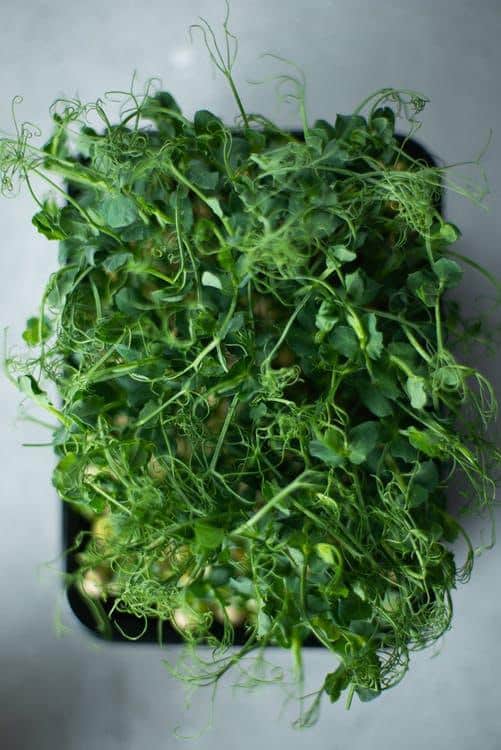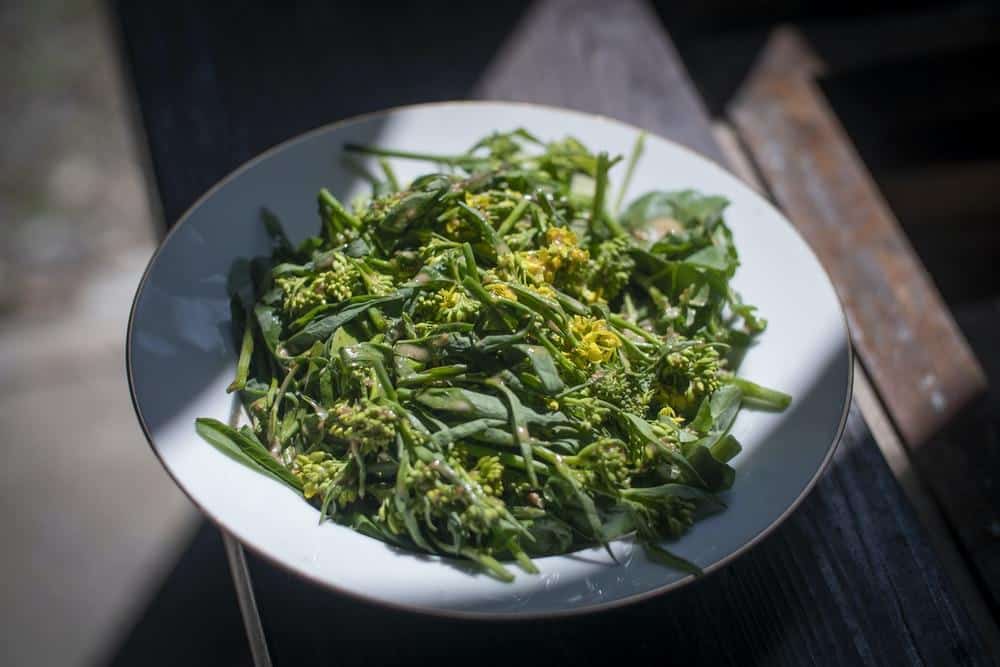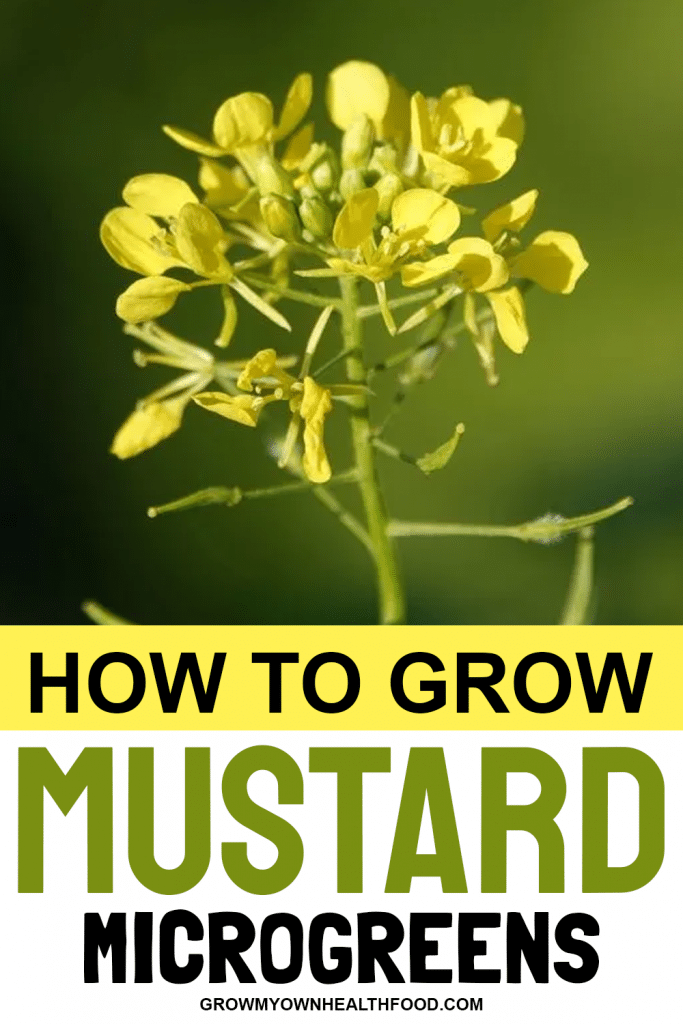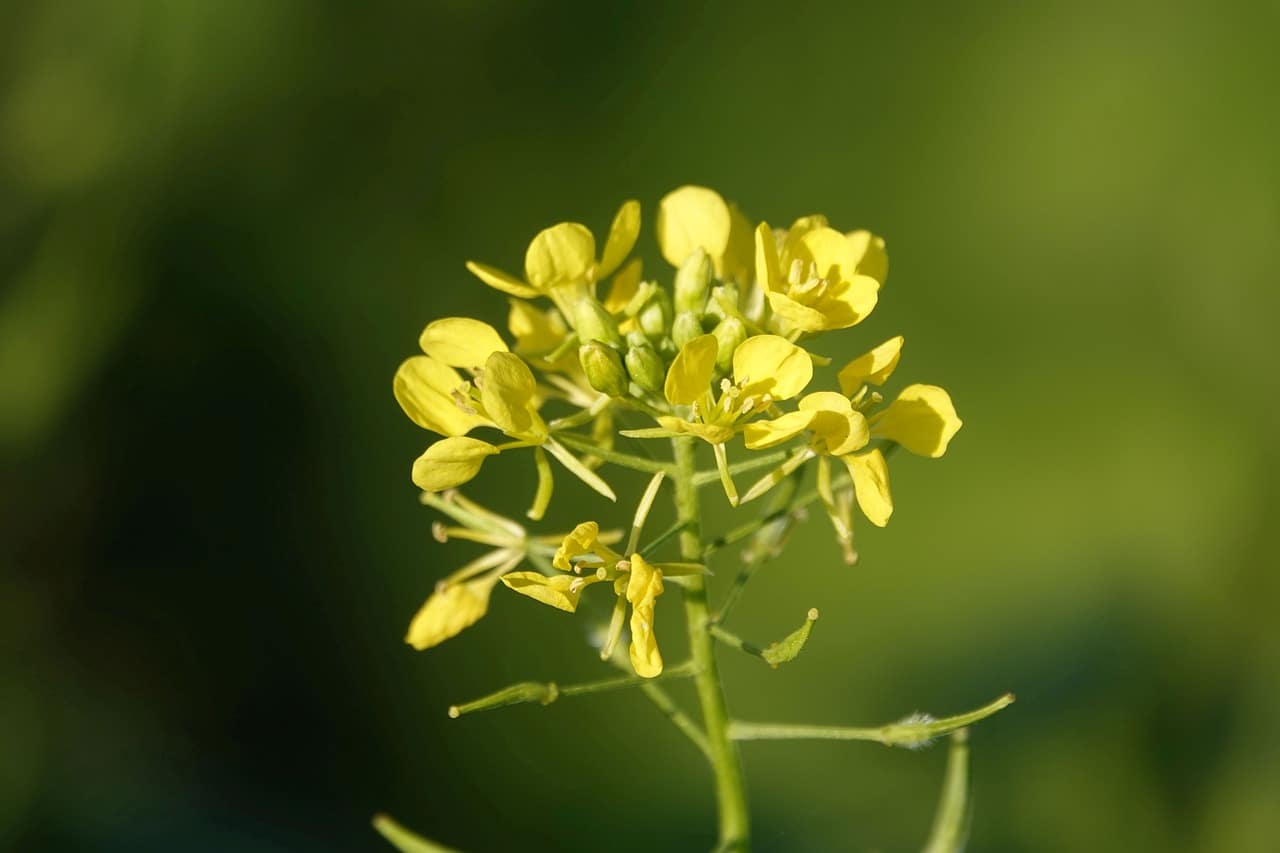There is a great variety of microgreens out there, some are easy to grow while some can be somewhat complicated. Growing mustard microgreens falls on the easy side of the spectrum. The small microgreens are not to be taken lightly, flavor and aroma wise they pack a punch. Moreover, as mustard comes from the Brassica genus.
Mustard Microgreen Benefits
Mustard microgreens contain a good number of vitamins, these vitamins range from Vitamins A, B6, C, K, and E. Many people claim that out of all the microgreens out there, mustard microgreens are one of the most flavorful and healthiest. Just to note, some people can have a mustard allergy. That said, these microgreens are easy to identify because of their white stems and almost pale green cotyledons. The mustard microgreens look a great deal like chia microgreens as well. If you are a fan of mustard, then instead of growing mature mustard plants try to grow mustard microgreens instead. These micros are in comparison more nutritious. Since there are a variety of them, including spicy mustard microgreens, you can go all out and grow different types of mustard microgreens for a more diverse taste.
Growing Mustard Microgreens Simply

If you are new to the world of growing plants then you might face a little difficulty in growing mustard microgreens. But do not worry at all, with the right set of guidelines even a rookie can easily grow mustard microgreens. First of all, you need to set your priorities straight, just like all other living things plants require love and care. Therefore, before diving deep into the world of planting make sure, you have the time for it. Another important factor will be the weather, the area you live in and the weather of that area will greatly impact the growth of the plant.
Materials Required for Growing Mustard Microgreens
(Complete Shopping List Below)
Since microgreens do not take up much space and are relatively easier to grow, the list of materials required for planting them is not that complex. As mentioned before there are a variety of mustard microgreen seeds. You need to pick which type of mustard microgreen you wish to grow or do you want to have a variety of mustard microgreens. You can choose from the Greenwave Mustard, Mizuna Mustard, and Mizuna Lime Streak Mustard, etc.
Furthermore, after you are done selecting seeds, you will need to find the right type of growing medium for the mustard microgreen. Simply using potting soil will not work for mustard microgreens, you can use the Espoma seed starter mix for growing mustard microgreens. Now mustard microgreens can be grown in shallow trays, you can try recycling some old trays or you can get some new ones. In general, two trays are needed, one with drainage holes and one without them. If you cannot find a tray with drainage holes you can simply may DIY drainage holes in the same tray.
Moreover, you will also need a high-quality growing light, for example, you can get the T5 grow lights. The last two items on the list of essentials are sharp scissors and a spray bottle. For mustard microgreens and various other herbs, kitchen shears prove to be the perfect tool. The spray bottle might seem like a dumb idea but it is utterly essential to have a spray bottle to ensure even distribution of water.
Mustard Microgreen Growing Essentials to Remember
There are certain things which when kept in mind will result in the yield of the perfect mustard microgreen. First thing is that mustard seeds are rather small if you want to get good results you need to make sure that you plant the seeds densely. Another point to note is that mustard seeds get all gooey when you put them in water therefore before plating them there is no need to soak them. Mustard seeds tend to grow better in the presence of a grow light rather than natural light.
The Planting Process for Mustard Microgreens
When it comes to the plating stage the first thing to do is to fill the drainage tray with soil to about 95% (almost to the brim). After which you are to gently smooth out the surface of the soil and remember to mist the soil with the spray bottle. Try to aim for equal spraying and then gently tamp down the moist soil surface with your palm or something flat. While ensuring that all seeds are equally spaced, scatter the seeds in the tray. Finally, place the other tray on top of the drainage tray and also put a weight on top of the tray. This will keep all light out and trigger the germination process.

The Growing Process
After about 2-3 days germination will start, in the meanwhile make sure to keep an eye on the moisture of the soil and mist the soil when needed. When the cotyledons are visible that is your cue to remove the cover and add the grow light. Don’t panic by the yellowish color of the leaves, they will be perfectly fine after they have been exposed to the grow light.
The Harvesting Mustard Microgreen Process
Five to fourteen days later the microgreens will be ready for harvesting. Be sure to harvest at the right time as the taste will change over time. When the leaves are fully opened and the microgreen has grown about 1-3 inches, this will indicate that the mustard microgreen is ready to be eaten. Before consuming the microgreen make sure to wash it thoroughly and store the excess in a sealed plastic bag and keep it refrigerated.

Equipment for Growing Mustard Microgreens
Mustard Microgreen Seeds
- Colorful Mustard Microgreens Mix - 1 Lb ~240,000 Seeds - Blend of Mustards including Green, Purple, and Red Mustard Seeds
- Non-GMO - Open Pollinated - Premium Seeds - High Germination Rate
- Microgreens & Baby Salad Greens Seeds
Prices pulled from the Amazon Product Advertising API on:
Product prices and availability are accurate as of the date/time indicated and are subject to change. Any price and availability information displayed on [relevant Amazon Site(s), as applicable] at the time of purchase will apply to the purchase of this product.
Spicy Microgreen Seed Mix
- SPROUT HOUSE ORGANIC SPROUTING SEEDS – 16 ounces of sprouting seeds.
- HOT & SPICY - Contains Certified Organic Non-GMO China Red Rose Radish and Yellow Mustard.
- RESEALABLE BAG – Only sprout what you need, the resealable bag will keep your seeds fresh.
Prices pulled from the Amazon Product Advertising API on:
Product prices and availability are accurate as of the date/time indicated and are subject to change. Any price and availability information displayed on [relevant Amazon Site(s), as applicable] at the time of purchase will apply to the purchase of this product.
Growing Trays
- Plant Germination Starter Kit: The seedling starter trays kit is made of PVC plastic material, and the quality is thicker, strong and not easy to deform.
- Greenhouse Grow Trays: In addition to planting vegetables, flowers, herbs and other plants in the soil, the base tray can also placing peat pellet.
- Seed Propagator Tray: 24-cell seed starting clone trays are convenient for centralized management, easy to operate and save your time and energy.
Prices pulled from the Amazon Product Advertising API on:
Product prices and availability are accurate as of the date/time indicated and are subject to change. Any price and availability information displayed on [relevant Amazon Site(s), as applicable] at the time of purchase will apply to the purchase of this product.
Epsoma Mix
- Premium Potting Mix
- Country Of Origin: United States
- Brand Name: Esp
Prices pulled from the Amazon Product Advertising API on:
Product prices and availability are accurate as of the date/time indicated and are subject to change. Any price and availability information displayed on [relevant Amazon Site(s), as applicable] at the time of purchase will apply to the purchase of this product.
Coconut Coir
- 100% Natural & organic, OMRI Listed. Each brick weighs 10 lbs
- High-grade coconut coir with low EC and pH levels
- 100% natural, renewable replacement for peat moss, rockwool & perl
Prices pulled from the Amazon Product Advertising API on:
Product prices and availability are accurate as of the date/time indicated and are subject to change. Any price and availability information displayed on [relevant Amazon Site(s), as applicable] at the time of purchase will apply to the purchase of this product.
Grow Light
- Perfect for indoor plants: light system for starting seeds, propagating cuttings and growing indoor flowers and houseplants
- Premium quality: T5 high output fluorescent fixture with wide reflector and one T5 bulb provides maximum coverage
- Measures approximately 25 by 18-1/2 by 30 Inch, super easy assem
Prices pulled from the Amazon Product Advertising API on:
Product prices and availability are accurate as of the date/time indicated and are subject to change. Any price and availability information displayed on [relevant Amazon Site(s), as applicable] at the time of purchase will apply to the purchase of this product.
Spray Bottle
- Our 32 ounce (about 950 ml) heavy duty spray bottles are made from HDPE plastic, recycle code # 2, which is chemically resistant, safe for chemical solutions.
- Our professional sprayer features a long lasting polypropylene spray head, tight and secure cap closure, internal cap gasket, 302 stainless steel spring and a precision valve and piston for a no clog and no leak experience.
- From a fine mist to a solid stream, the sprayer can be easily adjusted to suit your needs.
Prices pulled from the Amazon Product Advertising API on:
Product prices and availability are accurate as of the date/time indicated and are subject to change. Any price and availability information displayed on [relevant Amazon Site(s), as applicable] at the time of purchase will apply to the purchase of this product.
Mustard Microgreens Recipe
How to Grow Mustard Microgreens – Conclusion
Mustard microgreens are super easy to grow and they can add a new hint of flavor to your dishes. You can keep them stored for a good amount of time and have them handy for any mustard-related emergencies.














